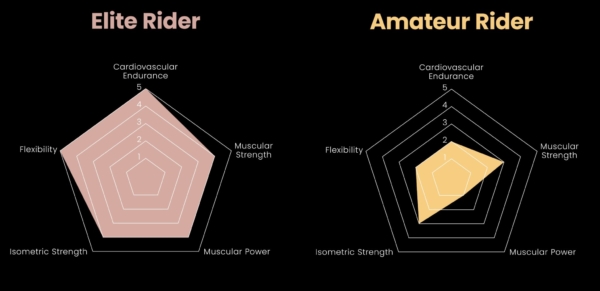There is so many opinions about the best way to train, how do I know I am making the right ones?
I watch the training elite riders do and wonder what changes I should make to my training to be more like them?
As the country begins to return to usual activities and we move steadily into the winter months, many of us find there are not enough hours in the day. It is often our rider training which falls to the bottom of the to-do-list. Ultimately we want to prioritize our time well, choose activities wisely and aim for the most efficient method to improve our show jumping. We need the right activities, taking the least time possible to achieve great results. So “training specificity” is a concept you might really like to address these needs. Training specificity has the ability to catapult your body to profound change and save time.

Specificity – training specific to your sport and specific to you
This week we will explain Specificity for your Sport. Next week we will explain Specificity for You (also known as Individualism):
Training specificity for show jumping in the broadest definition would suggest you get better at show jumping by riding your horse over jumps. The principle of specificity, when applied to sport, infers types of training modes should be relevant and appropriate to the requirements of the sport for which the individual is training in order to produce the desired effect. However lockdown means you’re not riding at the moment. We know show jumping requires a different balance of training modes than say a sport like rugby. So what activities can you do at home to help keep your training specific for show jumping?
Let’s consider what modes of training might be necessary for two people who both compete in show jumping. Imagine one is show jumping at elite level and the other at intermediate level.
That’s where metrics become very helpful. The more knowledge you have about the problem the more knowledge you will have about the solution.
For example look at these two simplified charts in the graphics below and compare the metrics of the elite rider with those of the intermediate rider.

If the goal of the graph is to drive the competency score up to 5 in each area (i.e. to increase the area covered by colour) then the rider would give attention to different activities during the week to bring up their score and cover more of the chart. They would choose training activities in those modes which remain sport specific.
The elite rider in this example would best choose sport specific activities which build their muscle strength and power. An example might be the ERB Pistol Squat hold for isometric conditioning and a lat. pull down resistance exercise for eccentric and concentric conditioning.
The intermediate rider has several areas to improve however we would recommend cardiovascular training mode activities which would improve their ability to train for longer periods assisting all areas over time. For example, ERB See Saw Abdominal Breathing Exercise and ERB Zone 2 Aerobic Training.
So you can see both individuals are show jumpers training specifically for the sport however the training modes they focus on would be different to drive up their individual competency scores.
To self-evaluate your current ability in each of the training modes, rate yourself out of 5 for each area (where 5 is fully capable and 1 is needs work). Next week, we will discuss training specificity further and how specificity may be applied to the individual as well.
If this raises questions about your own rider training decisions, please don’t be shy. We love taking questions and would love to see your results improve!
From the desk of EVENT READY BODIES
For more information contact us [email protected] or 06 3561494
ESNZ Jumping Team
11 May 2020